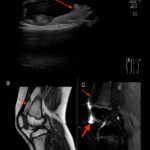Yalamanchili et al. describe how trends in disease-modifying anti-rheumatic drug (DMARD) use have evolved for insured, U.S. patients with juvenile idiopathic arthritis. Overall, the study found that from 2000 to 2022 in this patient population the use of biologic and targeted synthetic DMARDs rose, while the use of conventional synthetic DMARDs declined.

ACR Image Competition 2024 Results, Part 4
For the 2024 Image Competition, the ACR sought images with educational or remarkable manifestations representing a diverse range of pediatric patients with autoimmune, inflammatory, infectious and malignant drivers of rheumatic disease. Here, we showcase the winning images from the Middle East and North Africa. Lipoma Arborescens Revealed A 10-year-old boy, presented with a five-year history…

FDA Approval Sought for 2 Pediatric Indications for Guselkumab
The FDA is reviewing supplemental biologics license applications for guselkumab to treat children with juvenile psoriatic arthritis and moderate to severe plaque psoriasis.

3 AC&R Study Summaries: Fractures in Patients with SSc, Clinical Response in JIA, & TV & the Public Perception of Gout
Fractures in Patients with SSc By Zsuzsanna McMahan, MD, MHS Why was this study done? To minimize disability due to systemic sclerosis (SSc), it’s important to prevent and manage complications. Many SSc complications and related medications may increase the risk for osteoporosis and fracture. We sought to identify modifiable risk factors for fracture in patients…

3 AC&R Study Summaries: Treat to Target in Gout, Response to Biologics in Patients with JIA, & Rehabilitation Dose in Adults with RA
Treat to Target in Gout Monitoring & achievement of target serum urate levels By Jing Li & Gabriela Schmajuk, MD, MS Why was this study done? The ACR’s 2020 guideline for the management of gout recommends using a treat-to-target (T2T) approach to lower serum urate (SU). Using the ACR’s RISE registry, we examined the use…

Changing Treatment Patterns for Patients with JIA
A study from Glerup et al. demonstrated that many patients with juvenile idiopathic arthritis achieved drug-free remission over 18 years of follow-up and that remission rates remained stable between years 8 and 18 of the study period.
Patterns of Arthritis Flare
Similar patterns of inflammation occur in the joints of patients with inflammatory arthritis, but in each individual, arthritis affects only a subset of possible anatomic areas. Chang et al. set out to identify patient-specific anatomic patterns of joint flare to distinguish local from systemic drivers of chronic disease.

Baricitinib Promising for Juvenile Idiopathic Arthritis
In a study from Ramanan et al., baricitinib proved safe and effective for reducing the time to flare and frequency of flare in patients aged 2–18 years with juvenile idiopathic arthritis.

Never Too Late: Late-Breaking Abstracts Create Excitement
EULAR 2022 (VIRTUAL)—The pace of scientific progress in research medicine is incredible and seems to only accelerate with time. Thus, the 2022 Congress of the European Alliance of Associations for Rheumatology (EULAR) session on late-breaking abstracts fittingly captured the excitement and timeliness of a number of research projects that have just recently been completed and…

European Medicines Agency Committee Issues Positive Opinion for Secukinumab in Pediatric Arthritic Disease
In the E.U., secukinumab is edging closer to approval for use in pediatric patients with juvenile idiopathic arthritis (JIA), specifically those with enthesitis-related arthritis (ERA) and juvenile psoriatic arthritis (PsA). In May, the Committee for Medicinal Products for Human Use of the European Medicines Agency issued a positive opinion on expanding its indications.
- 1
- 2
- 3
- 4
- Next Page »